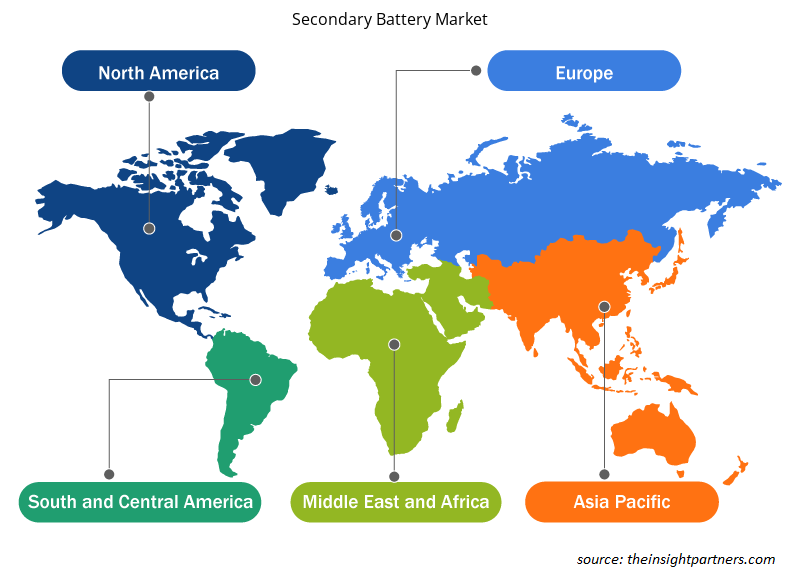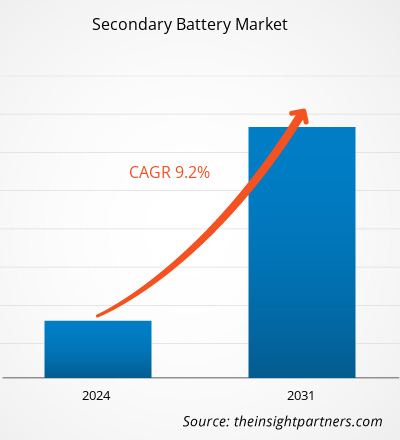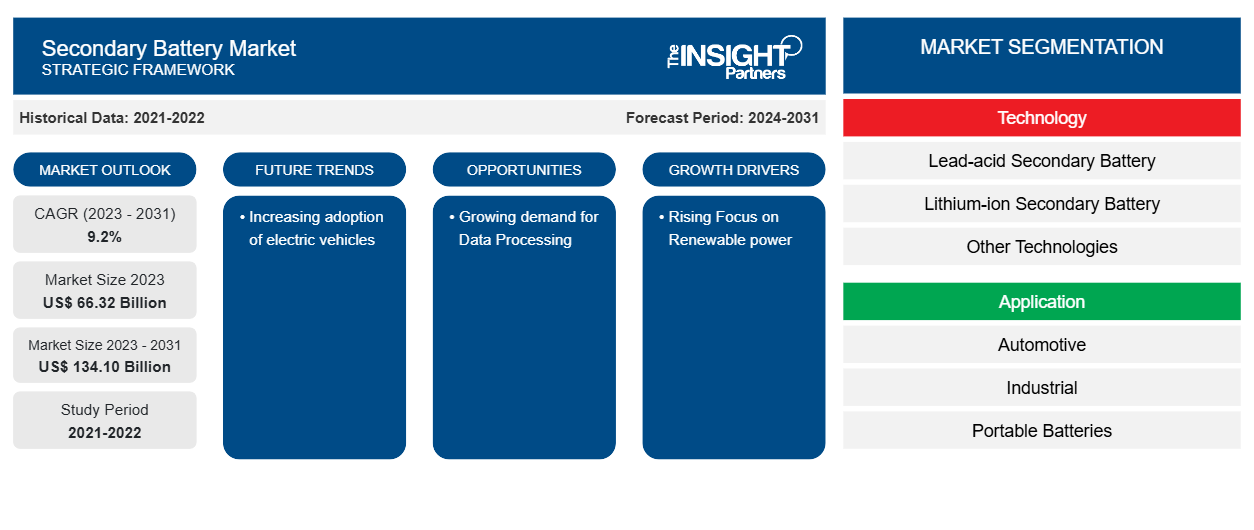Si prevede che le dimensioni del mercato globale delle batterie secondarie cresceranno da 66,32 miliardi di dollari nel 2023 a 134,10 miliardi di dollari entro il 2031; si prevede che si espanderà a un CAGR del 9,2% dal 2024 al 2031. È probabile che la crescente adozione di veicoli elettrici rimanga una tendenza chiave del mercato delle batterie secondarie.
Analisi del mercato delle batterie secondarie
La crescita del mercato globale può essere attribuita a fattori quali i progressi tecnologici, l'aumento delle industrie di consumo finale e il sostegno a livello di politica governativa per promuovere le infrastrutture di stoccaggio dell'energia.
Panoramica del mercato delle batterie secondarie
Una batteria ricaricabile, una batteria di accumulo o una cella secondaria (ufficialmente nota come accumulatore di energia) è un tipo di batteria elettrica che può essere caricata, scaricata in un carico e ricaricata più volte, al contrario di una batteria monouso o principale, che viene consegnata completamente carica e scartata dopo l'uso. È composta da una o più celle elettrochimiche. Il termine "accumulatore" si riferisce a qualcosa che raccoglie e immagazzina energia tramite un processo elettrochimico reversibile. Le batterie ricaricabili sono disponibili in una varietà di forme e capacità, dalle celle a bottone ai sistemi megawatt utilizzati per stabilizzare una rete di distribuzione elettrica. Vengono utilizzati vari materiali per elettrodi ed elettroliti, tra cui piombo-acido, zinco-aria, nichel-cadmio (NiCd), nichel-metallo idruro (NiMH), ioni di litio (Li-ion), litio ferro fosfato (LiFePO4) e polimero di ioni di litio.
Personalizza questo report in base alle tue esigenze
Riceverai la personalizzazione gratuita di qualsiasi report, comprese parti di questo report, o analisi a livello nazionale, pacchetto dati Excel, oltre a usufruire di grandi offerte e sconti per start-up e università
-
Scopri le principali tendenze di mercato in questo rapporto.Questo campione GRATUITO includerà analisi di dati che spaziano dalle tendenze di mercato alle stime e alle previsioni.
Driver e opportunità del mercato delle batterie secondarie
L'attenzione crescente verso l'energia rinnovabile favorisce il mercato
La generazione di energia rinnovabile sta diventando sempre più popolare in tutto il mondo, con Germania e Francia che guidano la diffusione della tecnologia delle energie rinnovabili. Tuttavia, questi paesi continuano a fare affidamento sulle importazioni nette di elettricità. Le nazioni emergenti, d'altro canto, stanno adottando l'energia rinnovabile diventando importatrici nette di energia a causa del crescente consumo di energia e dell'infrastruttura di rete insufficiente. Questa circostanza evidenzia la necessità vitale delle tecnologie di accumulo di energia, in particolare delle batterie secondarie , per fornire una fornitura costante di elettricità. Di conseguenza, si prevede che il mercato mondiale delle batterie secondarie si espanderà in modo significativo negli anni a venire.
Crescente domanda di elaborazione dati
La crescente domanda di elaborazione dati sta effettivamente alimentando la domanda per il mercato delle batterie secondarie. Ciò è dovuto a diversi fattori, tra cui i progressi tecnologici, la crescente domanda di elettronica portatile e il passaggio a fonti di energia rinnovabili. La domanda di batterie secondarie è guidata dai progressi tecnologici e dalla crescente domanda di elettronica portatile come smartphone, tablet e dispositivi indossabili. Questi dispositivi richiedono fonti di alimentazione affidabili ed efficienti e le batterie secondarie forniscono l'accumulo di energia necessario.fuelling the demand for the secondary battery market. This is due to several factors, including technological advancements, increasing demand for portable electronics, and the shift towards renewable energy sources. The demand for secondary batteries is driven by technological advancements and the increasing demand for portable electronics such as smartphones, tablets, and wearable devices. These devices require reliable and efficient power sources, and secondary batteries provide the necessary energy storage.
Analisi della segmentazione del rapporto sul mercato delle batterie secondarie
Segmenti chiave che hanno contribuito alla derivazione della tecnologia e dell'applicazione dell'analisi del mercato delle batterie secondarie.
- In base alla tecnologia, il mercato è diviso in batteria secondaria al piombo, batteria secondaria agli ioni di litio e altre tecnologie. Il segmento della batteria secondaria al piombo ha detenuto una quota di mercato maggiore nel 2023.
- In base all'applicazione, il mercato è diviso in automotive, industriale, batterie portatili , dispositivi medici, carrelli elevatori e altre applicazioni. Il segmento industriale ha detenuto una quota di mercato maggiore nel 2023.
Analisi della quota di mercato delle batterie secondarie per area geografica
L'ambito geografico del rapporto sul mercato delle batterie secondarie è suddiviso principalmente in cinque regioni: Nord America, Asia Pacifico, Europa, Medio Oriente e Africa e Sud America/Sud e Centro America. Il Nord America ha dominato il mercato delle batterie secondarie nel 2023. Il mercato delle batterie nella regione nordamericana, che comprende Stati Uniti, Canada e Messico, sta vivendo una crescita significativa a causa di fattori quali una forte attenzione allo sviluppo sostenibile e una maggiore consapevolezza degli effetti negativi delle automobili tradizionali. I crescenti livelli di inquinamento globale e la diminuzione della disponibilità di combustibili fossili hanno creato una domanda di soluzioni di trasporto ecocompatibili. In risposta a queste preoccupazioni, i produttori di automobili stanno adottando tecnologie avanzate e incorporando batterie agli ioni di litio nei veicoli ibridi ed elettrici (EV) per rispondere all'urgente necessità di salvaguardia ambientale.
Approfondimenti regionali sul mercato delle batterie secondarie
Le tendenze regionali e i fattori che influenzano il mercato delle batterie secondarie durante il periodo di previsione sono stati ampiamente spiegati dagli analisti di Insight Partners. Questa sezione discute anche i segmenti e la geografia del mercato delle batterie secondarie in Nord America, Europa, Asia Pacifico, Medio Oriente e Africa e Sud e Centro America.

- Ottieni i dati specifici regionali per il mercato delle batterie secondarie
Ambito del rapporto sul mercato delle batterie secondarie
| Attributo del report | Dettagli |
|---|---|
| Dimensioni del mercato nel 2023 | 66,32 miliardi di dollari USA |
| Dimensioni del mercato entro il 2031 | 134,10 miliardi di dollari USA |
| CAGR globale (2023-2031) | 9,2% |
| Dati storici | 2021-2022 |
| Periodo di previsione | 2024-2031 |
| Segmenti coperti |
Per tecnologia
|
| Regioni e Paesi coperti |
America del Nord
|
| Leader di mercato e profili aziendali chiave |
|
Densità degli attori del mercato: comprendere il suo impatto sulle dinamiche aziendali
Il mercato del Secondary Battery Market sta crescendo rapidamente, spinto dalla crescente domanda degli utenti finali dovuta a fattori quali l'evoluzione delle preferenze dei consumatori, i progressi tecnologici e una maggiore consapevolezza dei vantaggi del prodotto. Con l'aumento della domanda, le aziende stanno ampliando le loro offerte, innovando per soddisfare le esigenze dei consumatori e capitalizzando sulle tendenze emergenti, il che alimenta ulteriormente la crescita del mercato.
La densità degli operatori di mercato si riferisce alla distribuzione di aziende o società che operano in un particolare mercato o settore. Indica quanti concorrenti (operatori di mercato) sono presenti in un dato spazio di mercato in relazione alle sue dimensioni o al valore di mercato totale.
Le principali aziende che operano nel mercato delle batterie secondarie sono:
- Tecnologia Amperex limitata
- Società BYD Ltd
- Duracell Inc
- EnerSys
- Tecnologia contemporanea Amperex Co. Limited
- Società Panasonic
Disclaimer : le aziende elencate sopra non sono classificate secondo un ordine particolare.

- Ottieni una panoramica dei principali attori del mercato delle batterie secondarie
Notizie e sviluppi recenti sul mercato delle batterie secondarie
Il mercato delle batterie secondarie viene valutato raccogliendo dati qualitativi e quantitativi dopo la ricerca primaria e secondaria, che includono importanti pubblicazioni aziendali, dati associativi e database. Di seguito è riportato un elenco degli sviluppi nel mercato:
- Ad aprile 2024, BYD, un produttore di automobili cinese, è pronta a introdurre il suo pacco batteria "blade" di seconda generazione ad agosto 2024. Questa nuova tecnologia di batterie dovrebbe avere un'autonomia sufficiente per guidare un'auto elettrica da Sydney a Melbourne con una sola carica. Il pacco batteria blade di seconda generazione sarà basato sulla tecnologia proprietaria delle batterie agli ioni di litio fosfato (LFP) di BYD. Vale la pena notare che questa tecnologia supererà l'introduzione di batterie allo stato solido con un'autonomia dichiarata simile da parte di Toyota, attualmente pianificata per il 2026 al più presto.
(Fonte: BYD, Comunicato stampa, 2024)
Copertura e risultati del rapporto sul mercato delle batterie secondarie
Il rapporto "Dimensioni e previsioni del mercato delle batterie secondarie (2021-2031)" fornisce un'analisi dettagliata del mercato che copre le seguenti aree:
- Dimensioni e previsioni del mercato a livello globale, regionale e nazionale per tutti i segmenti di mercato chiave coperti dall'ambito
- Dinamiche di mercato come fattori trainanti, vincoli e opportunità chiave
- Principali tendenze future
- Analisi dettagliata delle cinque forze PEST/Porter e SWOT
- Analisi di mercato globale e regionale che copre le principali tendenze di mercato, i principali attori, le normative e gli sviluppi recenti del mercato
- Analisi del panorama industriale e della concorrenza che copre la concentrazione del mercato, l'analisi della mappa di calore, i principali attori e gli sviluppi recenti
- Profili aziendali dettagliati
- Analisi storica (2 anni), anno base, previsione (7 anni) con CAGR
- Analisi PEST e SWOT
- Valore/volume delle dimensioni del mercato - Globale, Regionale, Nazionale
- Industria e panorama competitivo
- Set di dati Excel
Report recenti
Rapporti correlati
Testimonianze
Motivo dell'acquisto
- Processo decisionale informato
- Comprensione delle dinamiche di mercato
- Analisi competitiva
- Analisi dei clienti
- Previsioni di mercato
- Mitigazione del rischio
- Pianificazione strategica
- Giustificazione degli investimenti
- Identificazione dei mercati emergenti
- Miglioramento delle strategie di marketing
- Aumento dell'efficienza operativa
- Allineamento alle tendenze normative























 Ottieni un campione gratuito per - Mercato delle batterie secondarie
Ottieni un campione gratuito per - Mercato delle batterie secondarie